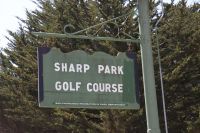MacKenzie And Wikipedia
/ If you read my Sharp Park story in Golf World--I know many of you have studied it and already cut it out for your scrapbooks--you'll know that Brent Plater, the primary environmentalist and San Francisco State lecturer lobbying for its closure "for the good of the game" is suggesting that Alister MacKenzie created a faulty design and furthermore, there is none of it left, so the course should go.
If you read my Sharp Park story in Golf World--I know many of you have studied it and already cut it out for your scrapbooks--you'll know that Brent Plater, the primary environmentalist and San Francisco State lecturer lobbying for its closure "for the good of the game" is suggesting that Alister MacKenzie created a faulty design and furthermore, there is none of it left, so the course should go.
(I know, don't even begin to ask things like, how would he know the design is faulty if he was not alive back then and none of it is left today to study.)
Mr. Plater has repeated this claim many times by citing Daniel Wexler's book, even appearing to repeat his claims under the name Arnold Palmer below Curt Sampson's story posted at golf.com (the misspelling of "McKenzie" is the same mistake in his early writings on Sharp Park and to me. Now, we architectural junkies bicker over MacKenzie's spelling, but the a in Mac is never an issue, it's that dreaded upper or lower case k).
Thanks to Mr. Plater's redundant message of MacKenzie's mistaken work at Sharp Park, I'm guessing that this hilarious modification to MacKenzie's Wikipedia page was the work of those hoping to see the course closed. Obviously the reference is totally out of context with the rest of the biographical sketch and will be edited out probably by the end of the week, so I'm offering a screen-capture and a copy-pasted version of the text for you to see just what kind of mudslinging the proponents of saving Sharp Park are dealing with.
Here's the text, unedited. Not exactly a graceful or appropriate or accurate transition.
MacKenzie worked in an era before large scale earth moving became a major factor in golf course construction, and his designs are notable for their sensitivity to the nature of the original site. He is admired for producing holes that offer an ideal balance of risk and reward, and for designing golf courses that challenge yet also accommodate players with a range of skills. The Sharp Park golf course in Pacifica has little resemblance to the initial design. Golf historian Daniel Wexler’s book “The Missing Links”: “Following the early 1930s deluge that washed several of (the course’s holes) out to sea, a massive berm was constructed (largely upon land once occupied by holes three and seven) to prevent history from repeating itself. The subsequent rerouting of the county road and reconfiguring of the lakeside holes has further muddled things so that today only a handful of holes run consistent with MacKenzie’s originals, and no appreciable trace of his strategy remains in play.”












